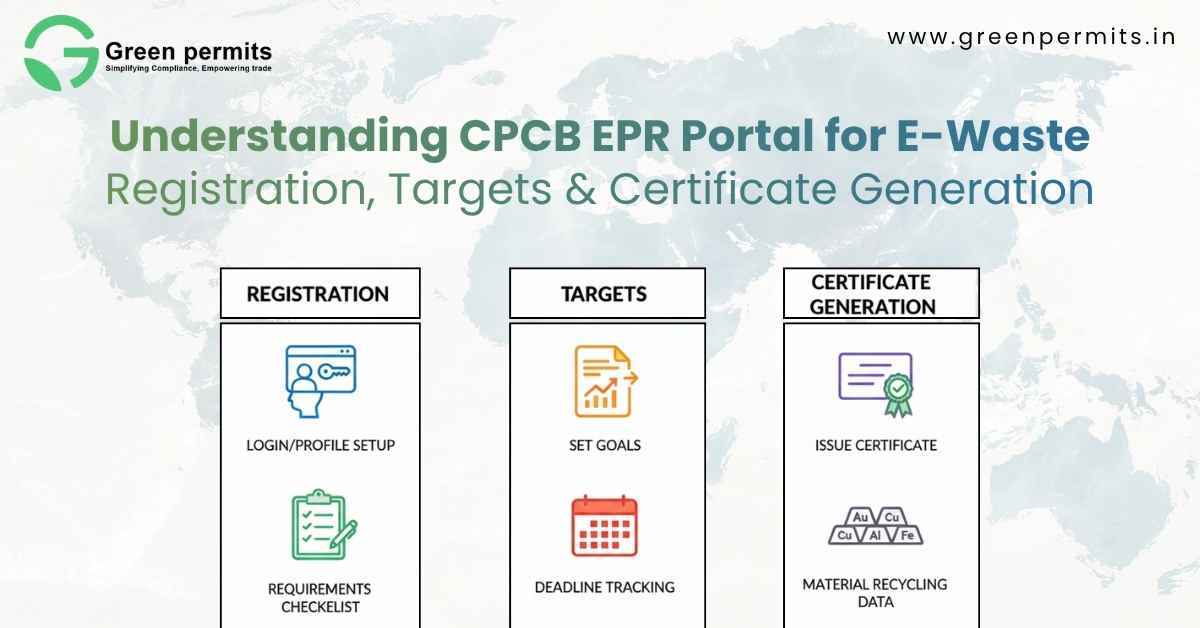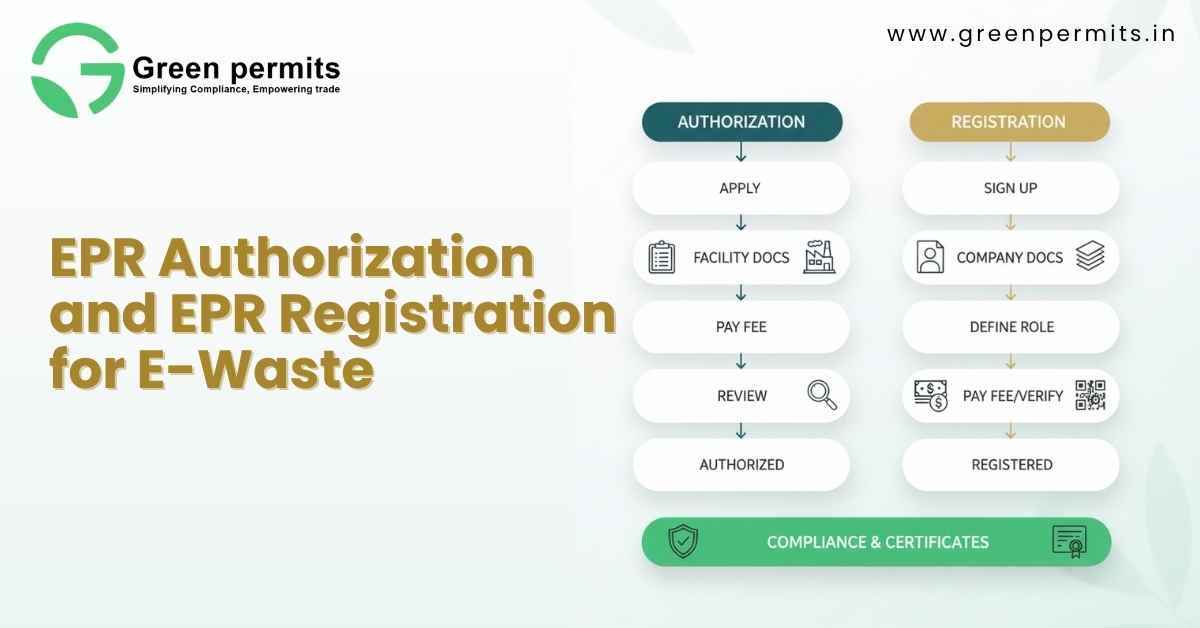When Orion Technologies Pvt. Ltd., a mid-sized electronics company in Pune, received an alert from the CPCB EPR Portal about “pending annual return,” their compliance manager thought it was routine paperwork. Within weeks, their EPR certificate count didn’t match the declared targets — causing a delay in license renewal and potential penalties.
This is a familiar story for many Indian producers and importers who register for EPR but struggle to decode how targets, recycling obligations, and annual reporting really work. Let’s simplify the process, step by step, and understand what every e-waste producer must do to stay compliant and stress-free.
Why EPR Targets Matter for E-Waste Producers
The Extended Producer Responsibility (EPR) framework ensures that manufacturers and importers take accountability for the electronic waste generated from their products. Once you register on the CPCB EPR Portal, you’re not just ticking a box — you’re entering into an ongoing responsibility to recycle a percentage of what you sell.
Why this matters to your business:
- Legal compliance: Non-submission of returns can lead to suspension of your registration and monetary penalties.
- Brand reputation: Consumers and corporate clients increasingly choose brands that demonstrate transparent recycling practices.
- Operational benefits: Meeting targets early gives you flexibility when EPR certificates become scarce near the filing deadline.
- Investor confidence: Compliance boosts ESG scores, a key factor in long-term funding and partnerships.
In short, EPR isn’t only a regulation — it’s a sign of a credible, responsible brand.
How Your EPR Target Is Calculated
Your annual EPR target depends on the quantity of electrical and electronic equipment (EEE) you placed on the Indian market and the average lifespan of each category. The CPCB portal automatically calculates obligations based on this data.
For Established Producers
If your products have been in the market longer than their average life span, your targets are calculated as a percentage of past sales. For example:
| Financial Year of Sale | Average Product Life (Years) | Target Year | Percentage of Quantity to Be Recycled |
|---|---|---|---|
| 2018-19 | 5 | 2023-24 | 60 % of 2018-19 sales |
| 2019-20 | 5 | 2024-25 | 70 % of 2019-20 sales |
| 2020-21 | 5 | 2025-26 | 80 % of 2020-21 sales |
The intent is to gradually increase recycling responsibility as domestic recycling infrastructure matures.
For New Producers
If your brand entered the market recently, you’ll report actual sales since launch. Targets apply only for the period corresponding to your product’s average life span. This prevents over-burdening newer companies but ensures traceability from the start.
Worked Example
A laptop brand selling 100 MT of units in FY 2020-21 (average life = 5 years) must recycle 80 MT by FY 2025-26. The CPCB portal auto-generates this obligation once sales and category data are submitted.
It’s vital to cross-verify that your Chartered Accountant’s certificate matches these entries before submitting your application.
Annual Return Filing for E-Waste Producers
Annual return filing is the proof of your compliance journey. It connects what you promised (targets) with what you achieved (certificates purchased and e-waste processed).
Step 1: Log In and Generate Report
Go to the Return section of the CPCB EPR Portal, select the relevant financial year and quarter, and click Generate Report.
Step 2: Review and Confirm Target Data
The system auto-populates your total sales, category-wise targets, and obligations. Check these carefully; incorrect entries can block approval or trigger audits.
Step 3: Upload Awareness and Recycling Proofs
Attach scanned documents showing awareness campaigns and recycling certificates purchased from authorised recyclers. For annual returns, this section is mandatory.
Step 4: Submit Sequentially
Quarterly returns must be filed in order — Q1 through Q4 — before you can submit the annual return. Once complete, confirm under the Submission tab.
| Return Type | Period Covered | Due Date (FY 2024-25) | Important Notes |
|---|---|---|---|
| Q1 | Apr–Jun 2024 | 30 Jul 2024 | Must be filed first |
| Q2 | Jul–Sep 2024 | 31 Oct 2024 | — |
| Q3 | Oct–Dec 2024 | 31 Jan 2025 | — |
| Q4 | Jan–Mar 2025 | 30 Apr 2025 | All four required before annual filing |
| Annual | FY 2024-25 | 30 Jun 2025 (extended to 15 Aug 2025) | Awareness section mandatory |
A best practice is to update sales and certificate data monthly so quarterly filings take only minutes instead of days.
Compliance Risks and Penalties
Ignoring EPR obligations can lead to suspension of your registration or imposition of environmental compensation by CPCB. Beyond penalties, non-compliance creates ripple effects: tender disqualifications, delayed renewals, and loss of business with environmentally conscious clients.
If a company repeatedly fails to meet targets, its EPR certificates may be frozen until discrepancies are cleared. Corrective action often costs much more than proactive compliance.
Best Practices for Smooth Compliance
- Keep your data consistent: Sales, certificates, and recycler details must match across CA reports and portal entries.
- Work only with authorised recyclers: Using unregistered facilities invalidates your certificates.
- Procure certificates early: Prices rise close to the deadline due to limited availability.
- Train your compliance team: Ensure at least one employee understands portal operations and target tracking.
- Audit quarterly: Have an external consultant verify your records every three months to detect gaps early.
These habits build a strong compliance culture and reduce year-end chaos.
A Real Business Example
Zenith Electroworks, a Gurugram-based SME, struggled with late filings during its first year of registration. After missing the Q2 deadline, they appointed an internal EPR coordinator and automated their sales-to-recycling data feed. The following year, they met 100 % of their target and renewed registration seamlessly.
The lesson? Consistency and early planning outweigh reactive paperwork.
Common Mistakes to Avoid
- Reporting sales in units instead of tonnes.
- Forgetting to attach CA-certified sales data.
- Mismatch between recycler certificate IDs and uploaded data.
- Ignoring the awareness activity section in the annual return.
- Submitting incomplete quarterly returns before annual filing.
A quick internal checklist before every upload can prevent all of the above.
Conclusion
EPR targets and returns filing may look complex, but with structured data and timely action, compliance becomes a routine business process rather than a last-minute scramble.
At Green Permits, we’ve helped dozens of producers streamline their filings, calculate accurate targets, and coordinate with certified recyclers so they never miss a deadline.
📞 +91 78350 06182 | 📧 wecare@greenpermits.in
Book a Consultation with Green Permits – get expert guidance on EPR target planning, annual return filing, and certificate management.
Book a Technical Call with Expert
FAQs
June 30, 2025, extended to August 15, 2025.
Sales and import data (in tonnes), CA-certified statements, and recycler EPR certificates.
Yes. Every registered producer, regardless of turnover, must file quarterly and annual returns.
They can be revised only before the CPCB portal closes for that period.
CPCB may impose environmental compensation or suspend the producer’s registration until compliance is achieved.



